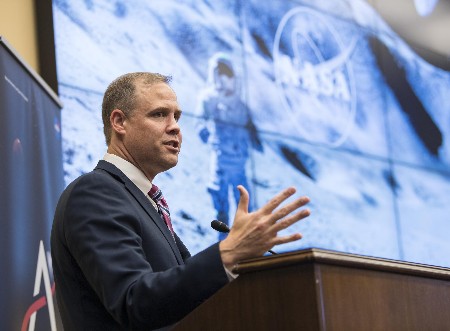
May 7, 2020 – When the news broke about plans for an adventure film involving Scientology’s number one poster boy, Tom Cruise, Jim Bridenstine, NASA’s non-scientist and former politician director, tweeted “NASA is excited to work with Tom Cruise on a film aboard the Space Station! We need popular media to inspire a new generation of engineers and scientists to make NASA’s ambitious plans a reality.”
So that’s what it takes to make NASA relevant today, an action-adventure shot in outer space. No doubt the actor who enjoys doing his own stunts will fly to the ISS aboard a Crew Dragon module, which will help Elon Musk in his publicity-seeking efforts to further promote SpaceX. What surprised me about this announced scoop from the Deadline website is that Musk gets mentioned only in the headline and not the copy.
The return to the Moon Artemis Program and NASA’s low-Earth orbit antics on the ISS are not about exploring the unknown of space. Instead, they are about keeping the human space program alive until it can become relevant once more. The ISS has been with us over 21 years. We have done a lot of interesting space science on board. We’ve even done some decent Earth observations from it. And we’ve been steadily learning the limits of our physiology in dealing with occupying near-Earth outer space for a prolonged period of time. We have no knowledge of what will happen to us when we enter Deep Space for prolonged periods of time. We can only speculate and hypothesize, and try to learn from what our science packages of sensed on robotic missions taking us beyond the relative safety of our near-Earth environment.
NASA has a history of political theatre used to meet a geopolitical agenda. The 1968 Christmas circling of the Moon by Apollo astronauts was such an event, a pre-emptive flight out of concern that the Soviets planned a similar effort. In the depths of the Cold War, the United States wanted a propaganda win and they got it. The initial landing on the Moon the following July happened while the Soviets were sending a robotic lander to that same destination to grab a lunar sample and return it to Earth before Neil Armstrong could say, “That’s one small step for man, one giant leap for mankind.” The Soviet attempt failed and got buried in the back pages of history.
NASA didn’t need a movie to make the Apollo 13 mission relevant to the world. It was described as the agency’s “finest moment” because it showed how engineers and scientists could collaborate with astronauts in peril in Deep Space and pull off a rescue that likely could have gone wrong a thousand ways. But since that moment in time, much of what NASA’s human space program has amounted to is station keeping. The shuttle was an enormous boondoggle that was pretty to watch and deadly to two astronaut crews. The enormity and cost of the ISS is a boondoggle as well. Smaller habitats in space could have served us as well and given us greater experience in learning how to build a permanent space infrastructure. Instead, we are talking about when we will end the ISS, the most expensive piece of space hardware ever put into Earth orbit. Will it be 2028, or sometime in the 2030s? Or will we sell pieces of it to commercial space companies at a dime on the dollar so that they can profit while building the space infrastructure that should have been a prime objective of NASA’s near-Earth human space program strategy.
When CNN picked up the Deadline scoop it put some context to the Tom Cruise story. The ISS is an international effort involving dozens of countries. The US and Russia are the principal operators of it and Americans pay up to $4 billion annually to maintain its operations. The research being done on it is partially funded by the government and by commercial companies seeking micro-gravity environments for their research and development. The cost to be onboard works out to about $11,250 per day for life support including use of the toilet, and $22,500 in total for food, air, and provisioning. Getting to it and coming home from it using the SpaceX Crew Dragon will add another $50 million to the bill. The bulk of that money will never reimburse American taxpayers. But moviegoers, or maybe Netflix subscribers will be able to watch Tom Cruise doing his own stunts in real outer space and not through the benefits of CGI while watching Mr. Scientology rake in millions of dollars more for himself and his “church.”
I guess there is no separation of church and state when it comes to NASA’s new publicity-seeking mantra under Bridenstine’s “leadership” and the Trump administration. The Artemis Program returning to the Moon by 2024 is an attempt to align a NASA milestone with the conclusion of a Trump second term. How far the agency has fallen from the science and engineering feats of the Apollo human space program, in becoming a lackey of its political masters in the White House.








